Algebraic Sum Example
Math / / July 04, 2021
In algebra, addition is one of the fundamental operations and the most basic, it is used to add monomials and polynomials. The algebraic addition is used to add the value of two or more algebraic expressions. As these are expressions that are composed of numeric and literal terms, and with exponents, we must be attentive to the following rules:
Sum of monomials:
The sum of two monomials can result in a monomial or a polynomial.
When the factors are equal, for example, the sum 2x + 4x, the result will be a monomial, since the literal is the same and has the same degree (in this case, no exponent). In this case we will add only the numerical terms, since, in both cases, it is the same as multiplying by x:
2x + 4x = (2 + 4) x = 6x
When expressions have different signs, the sign is respected. If necessary, we write the expression in parentheses: (–2x) + 4x; 4x + (–2x). Applying the law of signs, adding an expression preserves its sign, positive or negative:
4x + (–2x) = 4x - 2x = 2x.
In the case that the monomials have different literals, or in the case of having the same literal, but with different degree (exponent), then the result of the algebraic sum is a polynomial, formed by the two adding us. To distinguish the sum from its result, we can write the addends in parentheses:
(4x) + (3y) = 4x + 3y
(a) + (2a2) + (3b) = a + 2a2 + 3b
(3m) + (–6n) = 3m - 6n
When there are two or more common terms in the sum, that is, with the same literals and of the same degree, they are added together, and the sum is written with the other terms:
(2a) + (–6b2) + (–3a2) + (–4b2) + (7a) + (9a2) = [(2a) + (7a)] + [(–3a2) + (9a2)] + [(–6b2) + (–4b2)] = [9a] + [6a2] + [–10b2] = 9a + 6a2 - 10b2
Sum of polynomials:

A polynomial is an algebraic expression that is made up of additions and subtractions of the different terms that make up the polynomial. To add two polynomials, we can follow the following steps:
We will add 3a2 + 4a + 6b –5c - 8b2 with c + 6b2 –3a + 5b
- We order the polynomials in relation to their letters and their degrees, respecting the sign of each term:
4th + 3rd2 + 6b - 8b2
–3a + 5b + 6b2 + c
- We group the sums of the common terms: [4a –3a] + 3a2 + [6b + 5b] + [- 8b2 + 6b2] + c
- We carry out the sums of the common terms that we put between parentheses or brackets. Recall that since it is a sum, the term of the polynomial preserves its sign in the result: [4a –3a] + 3a2 + [6b + 5b] + [- 8b2 + 6b2] + c = a + 3a2 + 11b - 2b2 + c
Another way to illustrate this is by doing the addition vertically, aligning the common terms and performing the operations:

Sum of monomials and polynomials: As we can deduce from what has already been explained, to add a monomial with a polynomial, we will follow the revised rules. If there are common terms, the monomial will be added to the term; if there are no common terms, the monomial is added to the polynomial as one more term:
If we have (2x + 3x2 - 4y) + (–4x2) We align the common terms and perform the sum:

If we have (m - 2n2 + 3p) + (4n), we perform the sum, aligning the terms:
m - 2n2 + 3p
4n
m + 4n –2n2 + 3p
It is advisable to order the terms of a polynomial, to facilitate their identification and the calculations of each operation.
- It may interest you: Algebraic subtraction
Examples of algebraic addition:
(3x) + (4x) = 7x
(–3x) + (4x) = x
(3x) + (–4x) = –x
(–3x) + (–4x) = –7x
(2x) + (2x2) = 2x + 2x2
(–2x) + (2x2) = –2x + 2x2
(2x) + (–2x2) = 2x - 2x2
(–2x) + (–2x2) = –2x - 2x2
(–3m) + (4m2) + (4n) = –3m + 4m2 + 4n
(–3m) + (–4m2) + (4n) = –3m - 4m2 + 4n
(–3m) + (4m2) + (–4n) = –3m - 4m2 - 4n
(3m) + (4m2) + (4n) = 3m + 4m2 + 4n
(2b2 + 4c + 3a3) + (5a + 3b + c2) = 5th + 3rd3 + 3b + 2b2 + 4c + c2
(–2b2 + 4c + 3a3) + (5a + 3b - c2) = 5th + 3rd3 + 3b - 2b2 + 4c - c2
(2b2 + 4c - 3a3) + (5a + 3b - c2) = 5th - 3rd3 + 3b + 2b2 + 4c - c2
(2b2 - 4c + 3a3) + (5a + 3b + c2) = 5th + 3rd3 + 3b + 2b2 - 4c + c2
(2b2 + 4c + 3a3) + (–5a + 3b + c2) = –5a + 3a3 + 3b + 2b2 + 4c + c2
(–2b2 - 4c - 3a3) + (–5a - 3b - c2) = –5a - 3a3 - 3b - 2b2 - 4c - c2
(4x2 + 6y + 3y2) + (x + 3 x2 + and2) = x + 7x2 + 6y + 4y2
(–4x2 + 6y + 3y2) + (x + 3 x2 + and2) = x - x2 + 6y + 4y2
(4x2 + 6y + 3y2) + (x - 3 x2 + and2) = x + x2 + 6y + 4y2
(4x2 - 6y - 3y2) + (x + 3 x2 + and2) = x + 7x2 - 6y - 2y2
(4x2 + 6y + 3y2) + (–X + 3 x2 - Y2) = - x + 7x2 + 6y + 2y2
(–4x2 - 6y - 3y2) + (–X - 3 x2 - Y2) = - x - 7x2 - 6y - 4y2
(x + y + 2z2) + (x + y + z2) = 2x + 2y + 3z2
(x + y + 2z2) + (–X + y + z2) = 2y + 3z2
(x - y + 2z2) + (–X + y + z2) = 3z2
(x - y - 2z2) + (x + y + z2) = 2x - z2
(–X + y + 2z2) + (x + y - z2) = 2y + z2
(–X - y - 2z2) + (–X - y - z2) = - 2x - 2y - 3z2
Follow with:
- Algebraic subtraction



